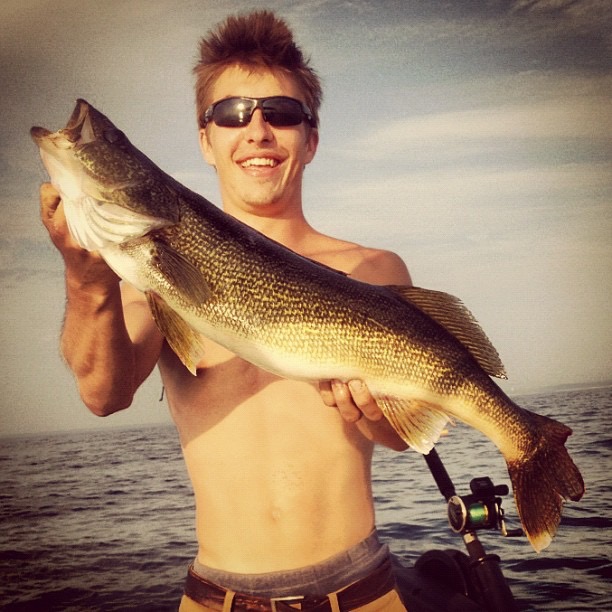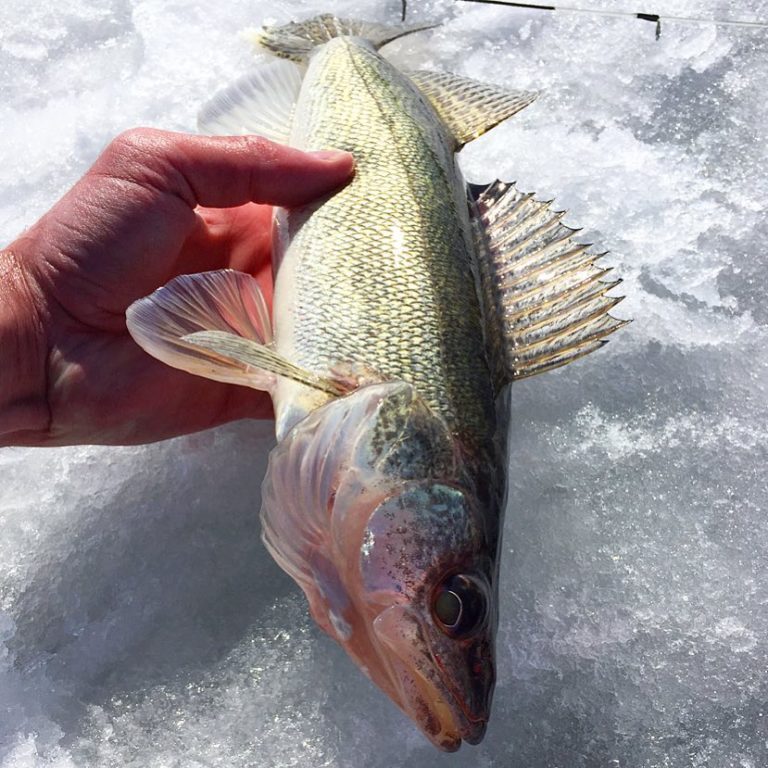The Walleye

The walleye (Sander vitreus) is a popular sport fish found throughout western New York. Walleye typically range between 18 and 24 inches in length and can be identified by their tall, spiny dorsal fin, brown colored body, and large, highly reflective eyes. Walleye also have sharp, needle like teeth. A walleye’s shape closely resembles that of its smaller cousin, the yellow perch. Walleye are popular among anglers because they are very tasty.
Habitat
Walleye prefer deep water, where they reside and prey on baitfish. A walleye’s eyes are adapted for hunting in low light conditions in clear water. Even though a walleye has excellent eyesight, they cannot hunt well in dirty water. Therefore, walleye are usually not found in water that is turbid.
In lakes, including Lake Erie, and deep creeks, walleye will often venture into the shallows at night to feed. A walleye’s excellent eyesight allows it to hunt very well at night. Hunting at night also allows walleye to avoid predators.
Food
Walleye eat primarily baitfish. However, they will probably also eat insects or crustaceans, especially in creeks.
Where to Catch Walleye
Walleye can be caught in many large lakes throughout western New York, including Lake Erie, and also in deep rivers and creeks including the Niagara River. Lake Erie is probably the number one walleye destination in western New York. Walleye can be taken from Lake Erie all summer long by trolling worm harnesses or stick baits in deep water from a boat.
Walleye can also be found in Lake Chautauqua and Silver Lake. Lake Chautauqua has a great walleye fishery, while Silver Lake’s is decent at best. During the warm months, walleye can be taken from Silver Lake and Lake Chautauqua by trolling the weed lines or vertical jigging near drop-offs and rock piles. At night, walleye can sometimes be taken from the shallows of both lakes. Silver Lake and Chautauqua Lake also provide good ice fishing opportunities for walleye. Check the DEC’s fishing hotline throughout the winter to monitor ice conditions and reported catches.
Some deep creeks also hold walleye. Another good area to target walleye is the Allegheny spillway. During the night, walleye can venture into the shallows of these creeks to feed. Otherwise, jigging in the deepest holes is probably the best place to find walleye.
Spring is the best time to target walleye without a boat. During the spring, when waters are still cold, walleye can be found within casting distance from shore in large lakes, especially at night. Casting stick baits or worm harnesses off tributary mouths at night in the springtime (April through June) can be productive when targeting walleye on Lake Erie.

How to Catch Walleye
Walleye can be caught on both live bait and artificial lures. Your rig will depend on how and where you are fishing. Nightcrawlers in general are a great natural bait for walleye. At or before dawn, drifting (on a boat) nightcrawlers on the bottom via a bottom-bouncer rig or a heavy jig head can produce fish. This technique works well when fishing the bays of Lake Erie from a boat and can also be used when fishing smaller lakes from a kayak.
Vertical jigging is also productive for targeting walleye. Vertical jigging is probably the best way to target walleye during the daytime. When vertical jigging, target drop-offs or rock piles. Good baits include either a whole nightcrawler or a curly tail grub or similar softplastic on a heavy jig head.
Stick baits and worm harnesses can also be used to target walleye. The biggest issue with using these baits is getting them down deep enough. Therefore, stick baits and worm harnesses usually lend themselves to use when trolling on a boat outfitted with downriggers. However, small lakes and creeks can sometimes be fished for walleye by trolling deep diving stick baits from a kayak or Jon boat.
